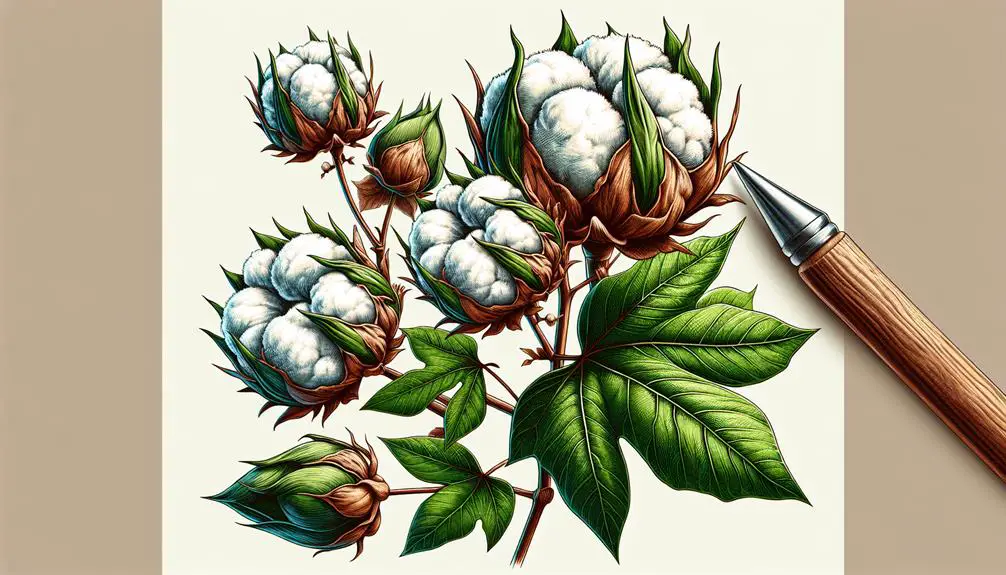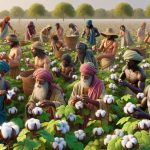Cotton, a plant with a fascinating history, has been around for thousands of years, shaping trade and fashion. From ancient civilizations like the Indus Valley to the Americas and Europe, cotton has left its mark. It spread through trade routes, influencing cultures and economies. The introduction of cotton to different parts of the world happened gradually, with each region adding its unique touch to the fabric's story. Intrigued? There's so much more to discover about cotton's journey through time and its impact on the fabric industry.
Table of Contents
Key Takeaways
- Cotton was introduced to Europe by Arab traders around 800 A.D.
- Columbus discovered Gossypium hirsutum in the Bahamas in 1492.
- Cotton cultivation began in the present-day USA by 1621.
- Moors brought cotton cultivation to Spain in the 800s.
- The East India Company imported rare cotton fabrics to Europe in the 1600s.
Ancient Origins of Cotton
Have you ever wondered where the ancient origins of cotton can be traced back to? Cotton has a fascinating history that dates back to ancient times. In the Old World, evidence of cotton cultivation can be found as far back as 5500 BC in the Indus Valley civilization. The domestication of cotton in the Americas, on the other hand, can be traced back to around 4200 BC in Peru.
Ancient cultures such as those in India, Egypt, China, and the Kingdom of Kush played significant roles in the cultivation and trade of cotton. The introduction of cotton to Greeks and Arabs during the Wars of Alexander the Great further spurred its cultivation and spread. The word 'cotton' itself has Arabic origins, stemming from the word قطن (qutn/qutun), reflecting the early cultural connections associated with this versatile plant.
Understanding the ancient origins of cotton provides valuable insights into its historical significance and the cultural exchanges that shaped its cultivation and trade over millennia.
Spread of Cotton Through Trade
Exploring the historical spread of cotton through trade reveals fascinating connections that shaped its global importance and impact. Arab traders played a pivotal role by introducing cotton cloth to Europe as early as 800 A.D., using established trade routes to expand its reach.
Columbus further influenced the cotton trade by discovering Gossypium hirsutum in the Bahamas in 1492, marking the introduction of American cotton varieties to the world market. The Moors brought cotton cultivation to Spain in the 800s, influencing European production methods and paving the way for the popularity of cotton textiles.
In the 1600s, the East India Company imported rare cotton fabrics to Europe, contributing significantly to the growing demand for cotton textiles. By 1621, cotton production had begun in parts of present-day USA, eventually leading to the development of a noteworthy cotton industry that continues to thrive today.
Cotton in Europes Popular Fabric
Cotton became Europe's most sought-after fabric in the 1700s, owing to its exceptional versatility and comfort. The Industrial Revolution played an important role in this shift, with cotton processing taking off in Britain. The East India Company also played a part by importing rare cotton fabrics to Europe in the 1600s, setting the stage for cotton's dominance.
Denim fabric, which originated in Nimes, France in the 1500s, gained popularity among sailors, particularly those from Genoa, adding to cotton's allure. By the 1760s, Europe saw the opening of the first cotton spinning factory in Manchester, UK, solidifying its position as a cotton powerhouse. This fabric not only provided comfort but also became a symbol of style and practicality.
The combination of the Industrial Revolution's advancements and the introduction of new fabrics like denim fueled Europe's love affair with cotton, making it a staple in the continent's textile industry.
Innovations in Cotton Production
Amidst the evolution of cotton production, genetic modification has revolutionized the industry by introducing Bt cotton varieties aimed at reducing pesticide use. This innovation targets pests like boll weevils, pink bollworms, and cotton aphids for sustainable cultivation.
By incorporating genetic material from the bacterium Bacillus thuringiensis (Bt), these cotton varieties enhance pest resistance, leading to improved crop yield and quality by reducing insect damage. The advancements in cotton production technologies, exemplified by Bt cotton, not only benefit the environment by minimizing pesticide use but also contribute to sustainable agriculture practices.
It's fascinating to witness how these innovations in cotton production are shaping the industry towards more efficient and environmentally friendly approaches.
Cotton Varieties Development
I'm excited to talk about the evolution of cotton varieties, where genetic modification has revolutionized the industry.
Organic cotton farming practices have gained momentum, emphasizing sustainability and environmental consciousness.
Additionally, the development of pest-resistant cotton strains has notably reduced the need for harmful pesticides.
Genetic Modification in Cotton
Developing genetically modified cotton varieties has revolutionized the cotton industry by greatly reducing pesticide use and enhancing crop sustainability. GM cotton, like Bt cotton, incorporates a Bt toxin gene from Bacillus thuringiensis for pest control. This innovation targets pests such as boll weevils, pink bollworms, and cotton aphids more sustainably.
The introduction of Bt cotton has led to a significant decrease in broad-spectrum insecticide applications during cotton cultivation. Globally, around 25 million hectares were planted with genetically modified cotton varieties in 2011, with India at the forefront of cultivation.
The benefits of GM cotton are evident, including increased yields, higher profits for farmers, and an overall reduction in pesticide usage.
Organic Cotton Farming
After exploring the advancements in genetic modification for cotton cultivation, let's now shift our focus to the domain of organic cotton farming and the development of cotton varieties through sustainable practices.
Organic cotton farming avoids synthetic pesticides and fertilizers, prioritizing soil health, biodiversity, and minimizing environmental impact. To create organic cotton varieties, traditional breeding methods are employed to enhance pest and disease resistance naturally.
The core goal of organic cotton farming practices is to enhance sustainability by reducing chemical inputs in cotton cultivation. Certification for organic cotton guarantees transparency and traceability of the farming methods utilized.
Pest-Resistant Cotton Strains
Embracing sustainable practices, cotton farmers have developed pest-resistant strains like Bt cotton to minimize pesticide usage in cotton cultivation. Bt cotton, containing genes from Bacillus thuringiensis, produces proteins toxic to harmful insects like boll weevils, pink bollworms, and cotton aphids. These genetically modified varieties aim to boost sustainability in cotton farming practices by reducing chemical inputs.
Insect attacks, such as those from leafworms and mites, can have a substantial impact on cotton yield and quality. By cultivating pest-resistant cotton strains, farmers can combat these pests more effectively while promoting environmentally friendly practices in the cotton industry.
Alexander the Greats Cotton Influence
Introducing cotton goods into Europe around 300 B.C., Alexander the Great's army played a pivotal role in the spread of cotton textiles through the Western world. During the Wars of Alexander the Great, cotton was brought to Greeks and Arabs, marking a significant turning point in the history of textiles.
The conquests led by Alexander the Great weren't only about expanding territories but also about disseminating new cultural elements, including the introduction of cotton fabrics. The influence of Alexander the Great's army was instrumental in bringing cotton to Europe, where it eventually became a staple in the textile industry.
This historical event marked the beginning of a new era for cotton in the Western world, setting the stage for its widespread adoption and integration into the fabric industry. The impact of Alexander the Great's cotton influence reverberates through history, shaping the way we perceive and use cotton textiles today.
Cottons Impact on Fabric Industry
Cotton's impact on the fabric industry was immense – it played a pivotal role in shaping textile production and manufacturing.
The invention of the cotton gin by Eli Whitney revolutionized the way cotton was processed, leading to a surge in cotton fiber availability for textiles.
This shift catapulted cotton to the forefront of fabric industry materials, fueling economic growth and industrial advancements.
Fabric Industry Influence
Revolutionizing the fabric industry, cotton emerged as Europe's most popular fabric in the 1700s. This shift wasn't just a trend; it was a game-changer. Here are some key points illustrating cotton's impact on the fabric industry:
- The invention of the cotton gin by Eli Whitney revolutionized cotton processing, making it more accessible for the textile industry.
- Cotton fabrics from the Americas brought advanced technical qualities to fabric production in the 1530s.
- Denim fabric, born in Nimes, France in the 1500s, gained popularity among sailors from Genoa, showcasing cotton's influence on fabric choices.
- The East India Company's importation of rare cotton fabrics to Europe in the 1600s played a pivotal role in expanding cotton's influence in the fabric industry.
Textile Production Impact
Influencing the fabric industry immensely, cotton's impact on textile production has been transformative over the centuries. The introduction of inventions like the spinning jenny and spinning mule during the Industrial Revolution in Britain boosted cotton manufacturing, making it Europe's most popular fabric in the 1700s.
Cotton cultivation in the Southern USA in the early 1800s turned the region into a major cotton exporter, fueling the industry's growth. Inventions in the 1760s enabled mass production of cotton cloth, further revolutionizing the textile industry.
Additionally, denim fabric, originating in France in the 1500s, gained popularity for everyday wear in the 1940s, showcasing cotton's versatility and lasting impact on textile production.
Frequently Asked Questions
When Was Cotton Introduced?
Cotton was introduced at different times in history. In the Old World, it entered during Alexander the Great's Wars, impacting Greek and Arab cultures. In the Americas, cotton cultivation traces back to around 4200 BC, with Peru playing a key role.
What Is the Importance of Cotton?
Cotton plays a pivotal role in textiles, economies, and trade. Its fibers are versatile and valuable, used in clothing, furnishings, and beyond. The global impact of cotton on various sectors underscores its significance in today's world.
How Does Cotton Start?
Cotton starts with domestication in the Americas around 4200 BC, spreading to the Old World by 5500 BC. Its introduction to Greeks, Arabs, and Europe happened through various historical events like the Wars of Alexander the Great and Arab merchants' trade.
What Are 5 Facts About Cotton?
Cotton has a rich history dating back to 4200 BC in the Americas. It holds Arabic origins and played an essential role in ancient civilizations like India and Egypt. The trade eventually shifted to the US and the Caribbean.
- Tetron Fabric for Marine Applications: Durability and Use Cases - June 18, 2025
- Tetron Fabric for Outdoor Furniture: Weather Resistance and Care - June 18, 2025
- Tetron Fabric for Wall Coverings: Style and Application Tips - June 18, 2025







